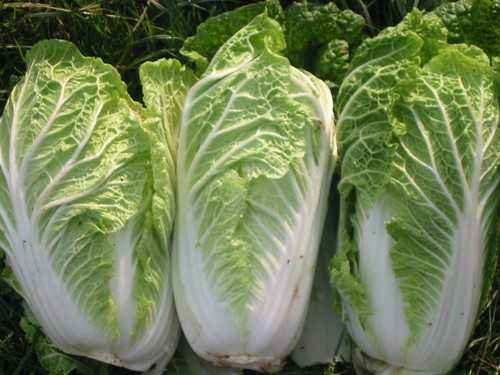Clár ábhair
Cabáiste Síneach: buntáistí agus díobhálacha
Many people know that cabbage and lettuce have been highly valued at all times for their medicinal and nutritional properties. But the fact that Peking – or Chinese – cabbage can replace these two products is probably not even known to all experienced housewives.
Peking cabbage has been sold in the markets for more than one year. Once upon a time, long oblong heads of cabbage were brought from afar, they were not cheap, and few people knew about the amazing properties of this vegetable. Therefore, Beijing cabbage for some time did not arouse much interest among the hostesses. And now they have learned to grow it almost everywhere, which is why the vegetable has fallen in price, and even a boom in healthy lifestyles and proper nutrition – the popularity of Chinese cabbage has skyrocketed.
What kind of beast is this …
Judging by the name, it is easy to guess that Chinese cabbage comes from the Middle Kingdom. “Petsai”, as this cabbage is also called – an annual cold-resistant plant, is grown in China, Japan and Korea. There she is held in high esteem. Both in the garden and on the table. Peking cabbage is one of the varieties of early maturing Chinese cabbage, it has head and leafy forms.
The leaves of the plant are usually collected in a dense rosette or heads of cabbage, resembling Roman salad Romaine in shape and reaching a length of 30-50 cm. The head of cabbage in the cut is yellow-green. The color of the leaves can vary from yellow to bright green. The veins on the leaves of Peking cabbage are flat, fleshy, wide and very juicy.
Peking cabbage looks remarkably similar to cabbage lettuce, which is why it is also called lettuce. And obviously, not in vain, because the young leaves of Peking cabbage completely replace lettuce leaves. This is perhaps the most juicy variety of cabbage, so the young and tender Peking leaves with a pleasant taste are perfect for making a variety of salads and green sandwiches.
Almost all the juice is not in green leaves, but in their white, denser part, which contains all the most useful components of Peking cabbage. And it would be a mistake to cut and discard this most valuable part of the cabbage. You must definitely use it.
… and with what it is eaten
In terms of juiciness, no salad and no cabbage can be compared with Peking. It is used to make borscht and soups, stew, cook stuffed cabbage … Whoever cooked borscht with this cabbage is delighted, and many other dishes with it have a pleasant taste and sophistication. In a salad, for example, it is much softer.
In addition, Peking cabbage differs from its closest relatives in that, when cooked, it does not emit such a specific cabbage smell, as, for example, white cabbage. In general, everything that is usually prepared from other varieties of cabbage and lettuce can be prepared from Peking. Fresh Chinese cabbage is also fermented, pickled and salted.
Kimchi by the rules
Who hasn’t admired the Korean kimchi salad made from Chinese cabbage? Fans of spicy from this salad are just crazy.
Kimchi is the most favorite delicacy among Koreans, which is almost the main thing in their diet, and practically no meal is complete without it. And as Koreans believe, kimchi is a must-have dish on the table. Korean scientists, for example, found that the content of vitamins B1, B2, B12, PP in kimchi even increases compared to fresh cabbage, in addition, there are many different biologically active components in the composition of the juice released during fermentation. So it is probably not for nothing that old people in Korea, China and Japan are so vigorous and hardy.
Conas atá sé úsáideach
Even the ancient Romans attributed hygienic properties to cabbage. The ancient Roman writer Cato the Elder was sure: “Thanks to cabbage, Rome was cured of diseases for 600 years without going to a doctor.”
These words can be fully attributed to Peking cabbage, which has not only dietary and culinary characteristics, but also medicinal ones. Peking cabbage is especially useful for cardiovascular diseases and stomach ulcers. It is considered the source of active longevity. This is facilitated by the presence in it of a significant amount of lysine – an amino acid that is indispensable for the human body, which has the ability to dissolve foreign proteins and serves as the main blood purifier, and increases the body’s immunity. Long life expectancy in Japan and China is associated with the consumption of Peking cabbage.
In terms of its content of vitamins and mineral salts, Peking cabbage is not inferior to white cabbage and its twin brother – cabbage salad, and in some respects even surpasses them. For example, in white cabbage and head lettuce, vitamin C contains 2 times less than in “Peking”, and the protein content in its leaves is 2 times higher than in white cabbage. Peking leaves contain most of the existing set of vitamins: A, C, B1, B2, B6, PP, E, P, K, U; mineral salts, amino acids (16 in total, including essential ones), proteins, sugars, lactucine alkaloid, organic acids.
But one of the main advantages of Peking cabbage is the ability to preserve vitamins throughout the winter, unlike lettuce, which, when stored, very quickly loses its properties, and white cabbage, which, of course, cannot replace lettuce, and besides, it requires specific storage conditions.
Therefore, Peking cabbage is especially indispensable in the autumn-winter period, since at this time it is one of the sources of fresh greens, a storehouse of ascorbic acid, essential vitamins and minerals.










